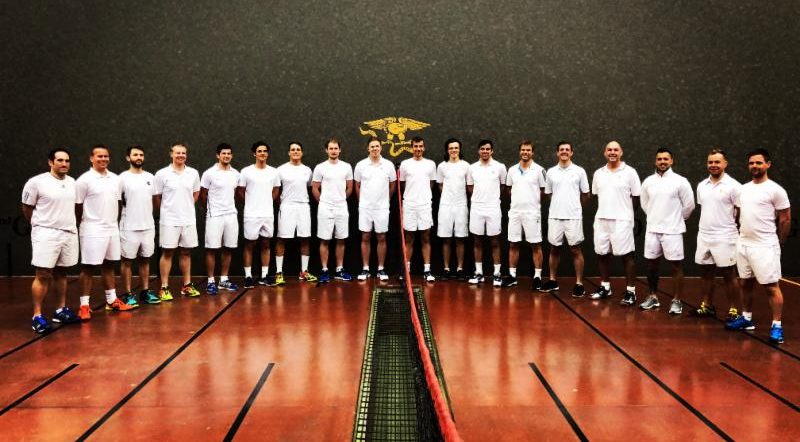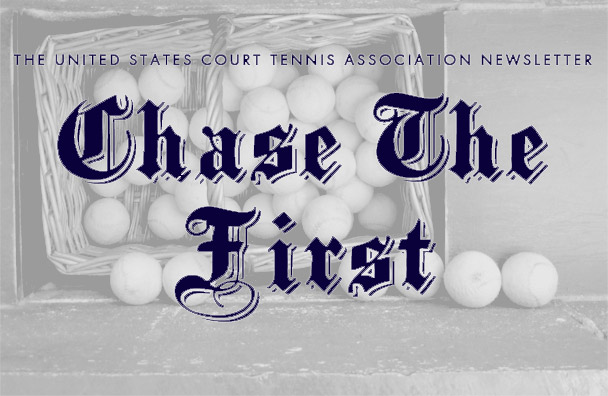This past summer we were strolling through the National Portrait Gallery in London and came upon a special exhibit, the BP Portrait Award 2012. In its thirty-third year, the Portrait Award is a major event in the art world; this year the NPG selected fifty-five works from over two thousand entries. Some of them were fantastic, others outer-wordly. On one wall, we stumbled upon someone we knew: the world champion of tennis.
“Rob Fahey on Court,” by Rupert Alexander, is an oil on canvas measuring 3.1 feet by 2.2 feet and depicts Rob on the hazard side of the court at Lord’s. It is a wonderful, insightful portrait.
Born in London, Alexander made headlines in 1998 when he painted portraits of the Prince of Wales and the Duke of Edinburgh when he was just twenty-three years old. In 2010 he painted the Queen; he was quoted in the papers at the time saying he and the Queen, during her sittings, talked about his great-uncle who once was a press attaché for Earl Mountbatten, the Queen’s second cousin once removed. Alexander also exhibited in the BP Portrait Award 2007.
The National Portrait Gallery said Alexander “aimed to show [Fahey’s] dominance in the sport and something of the atmosphere of the enclosed space.”
Below are an interview with Rupert Alexander and responses from Rob Fahey and Claire Vigrass.
USCTA: How did the project with Rob Fahey come about?
Rupert Alexander: The portrait was commissioned by the MCC [Marylebone Cricket Club] at Lord’s. For the past few years the MCC has been adding to their famed art collection by commissioning portraits of sportsmen and women associated with Lord’s. This ongoing project has, of course, generally involved portraits of cricketers, but given Rob Fahey’s unprecedented domination of real tennis it was decided that a portrait of him should also be commissioned to hang alongside the likes of Viv Richards and WG Grace. I had previously produced portraits for Lord’s and so was approached about a portrait of Rob.
USCTA: Did you know much or anything about real tennis beforehand?
RA: I confess that I knew very little about the sport. The first time I saw it played was at the 2009 British Open Final at Queens, which was, predictably, won by Rob—so I had the best possible introduction to the sport. I have been a life-long fan of (regular) tennis, so I was fascinated to see the sport from which tennis derived. Once I had got to grips with the rules (which, admittedly, took half the match) I was hooked. The skill, athleticism and cunning of the players [in the final Rob beat Steve Virgona 5-6, 6-5, 6-2, 6-4] was very compelling.
The British Open, in fact, was the only match I saw before starting the painting. It was enough to give me a feel for the game and for Rob’s demeanor on court.
USCTA: Rob has been world champion for eighteen years and as such is a legendary figure within the game. What was your first impression of Rob and how did your impressions evolve as you got to know him?
RA: Rob is entirely down to earth and unpretentious. His demeanor seems unaffected by the fact that he is perhaps the greatest player in the sport’s long history. When I asked him if his was the best record in real tennis history, he modestly brushed off the question with “Well, I don’t know—there was a guy in the 19th century who did rather well.” When playing he has a relentless focus and determination as well as an economy and precision of movement around the court. This carries even into the way he drinks from his water bottle between sets.
During the sittings at my studio, I got to know him quite well. He has an appealingly dry sense of humor and a very relaxed manner. He was also very tolerant of my obliging him to hold torturous poses for the painting.
USCTA: Tell us about the actual portrait. Did you have Rob sit at Lords or did he come to your studio? Photographs?
RA: When I was first commissioned to paint the portrait, the brief was entirely open: there was no stipulation that the portrait be set on court. When I first walked onto the court at Lord’s, however, it was immediately clear that the painting should be set there. The court has a wonderfully rich, almost church-like atmosphere, which lends itself to painting. The light from the vast skylight in the vaulted ceiling is beautiful: subdued yet expansive.
My aim was to suggest Rob’s dominance in the sport, expressed in part through a steep upward perspective. And I wanted to convey his complete sense of belonging on the court: this is his arena and his opponent is a guest in his house.
USCTA: How long did the whole process take?
RA: Rob very patiently came to my studio on six or seven occasions, and meanwhile I set up camp at Lord’s to paint an oil study of the court. I then married the studies of Rob with that of the court. I had a very particular idea for the tonal structure of the painting: the light focused at far end of the court, with the figure cast into half-light. The chief difficulty was getting the light falling on the two elements (the figure and the court) to match.
USCTA: What happened after it was finished?
RA: Once the painting was finished, it was unveiled at Lord’s. The committee then kindly agreed that the painting should be submitted to the National Portrait Gallery so that it could hang at the annual portrait exhibition, the BP Portrait Award. After it has hung in London for the summer it will hang at the Scottish National Portrait Gallery in Edinburgh for a few months before returning to Lord’s.
USCTA: Did you attend the world championships at Queens in April—are you now keen on real tennis?
RA: Unfortunately I was out of the country at the time, but I was delighted to hear that Rob won his tenth defense of the world championship—an astounding achievement. I’m hoping, though, to make it to the European Open at Lord’s in October. Having spent so long painting the court, it will be nice to sit back and watch others labor on it.
Rob Fahey responds:
I’m very pleased that someone has seen the portrait in its current position. It is all very exciting for me as you could imagine. I was honored when the MCC made me an honorary life member last year, and then for the sub-committee to turn around and commission a portrait was very serious icing on the cake.
Rupert and I had two sittings on court but mostly they were done in his studio in South London, about another six sittings roughly.
The first time I saw the painting, it was hanging in the Committee Room at Lords. It was an incredibly proud moment and not one I will forget in a hurry. The reaction at Lords has been very positive right from the announcement of the commission. Rupert has done an amazing job with the painting and it has been very well received by the club as an appropriate way to recognize my contribution to the game.
Seeing the finished work in the familiar surroundings of Lords was one thing, but seeing it hanging in the National Portrait Gallery with a couple of hundred other people was a very surreal and self-conscious moment. Of course, it being there had nothing to do with me. The portrait was chosen from more than two thousand portraits from over seventy countries and is a testament to Rupert’s immense skill and talent. I’m very proud of it but all congratulations must go to him.
Claire Vigrass responds:
Rob went to multiple sittings over three months or so. I went to one of the sittings and it was pretty impressive. I’m not sure what I had thought happened in these portrait sittings before but the model (in this case Rob) has to literally stand in these positions for hours on end, sometimes holding the same pose for up to four hours at a time. A lot of photos were taken. On one occasion Rupert Alexander came into Lords, and I had to put on Rob’s shoes (Rob was away at the time) and pose in the correct position so he could take photos of the how the light should be on the shoes. Incredibly fine detailed and an amazing outcome.
I saw it for the first time in the NPG and was amazed at how realistic it was. The lighting on the court is so hard to portray but he didn’t miss a thing. What stands out is the look on Rob’s face—frighteningly close. Rob had seen it before this, but we were invited to a private dinner for the unveiling of the exhibition, which was quite an experience.
To learn more about the BP Portrait Award 2012:
To learn more about Rupert Alexander:
http://www.rupertalexander.com/bio.html


